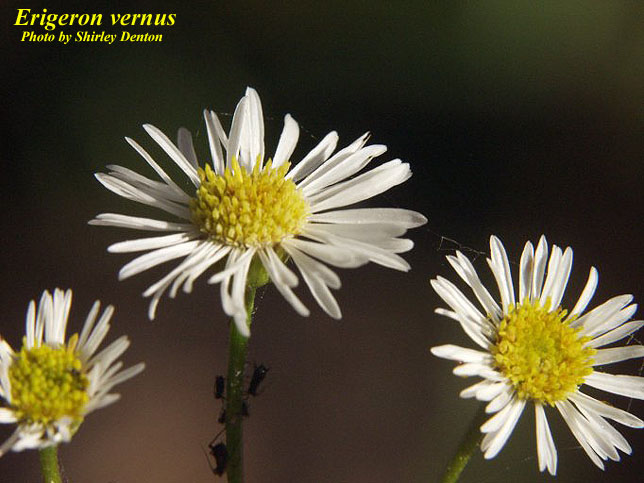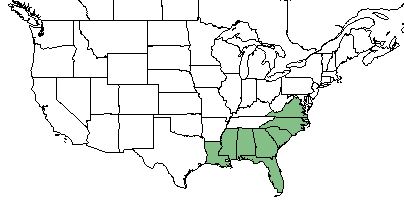Difference between revisions of "Erigeron vernus"
(→Ecology) |
(→Fire ecology) |
||
| Line 38: | Line 38: | ||
<!--===Seed bank and germination===--> | <!--===Seed bank and germination===--> | ||
===Fire ecology=== | ===Fire ecology=== | ||
| − | + | ''E. vernus'' has been considered fire-stimulated. It largely flowers after a recent burn, particularly in pine savanna habitats. <ref name ="FFE">Observation by Edwin Bridges on Floyd Griffith post, December 3, 2017 posted to Florida Flora and Ecosystematics Facebook Group. </ref> | |
<!--Fire tolerance, fire dependence, adaptive fire responses--> | <!--Fire tolerance, fire dependence, adaptive fire responses--> | ||
| − | <!--===Pollination===--> | + | <!--===Pollination===--> |
| + | |||
===Use by animals=== <!--Herbivory, granivory, insect hosting, etc.--> | ===Use by animals=== <!--Herbivory, granivory, insect hosting, etc.--> | ||
''E. vernus'' has poor forage value. <ref name= "Hilmon 1964"> Hilmon, J. B. (1964). "Plants of the Caloosa Experimental Range " U.S. Forest Service Research Paper SE-12 </ref> | ''E. vernus'' has poor forage value. <ref name= "Hilmon 1964"> Hilmon, J. B. (1964). "Plants of the Caloosa Experimental Range " U.S. Forest Service Research Paper SE-12 </ref> | ||
Revision as of 13:52, 2 July 2018
Common name: early whitetop fleabane [1], whitetop fleabane [2]
| Erigeron vernus | |
|---|---|

| |
| Photo by the Atlas of Florida Plants Database | |
| Scientific classification | |
| Kingdom: | Plantae |
| Division: | Magnoliophyta - Flowering plants |
| Class: | Magnoliopsida - Dicots |
| Order: | Asterales |
| Family: | Asteraceae |
| Genus: | Erigeron |
| Species: | E. vernus |
| Binomial name | |
| Erigeron vernus L | |

| |
| Natural range of Erigeron vernus from USDA NRCS Plants Database. | |
Contents
Taxonomic Notes
Synonyms: none
Varieties: none
Description
E. vernus is a perennial forb/herb of the Asteraceae family native to North America. [1]
Distribution
E. vernus is found along the southeastern coast of the United States from Louisiana to Virginia. [1]
Ecology
Habitat
E. vernus proliferates in wet savannas, seepages, and interdunal swales. [2] Specimens have been collected from edge of pond, dry loamy sands, wet pine flatwoods, hardwood swamp, peaty ditch, cypress swamp, prairie, hillside bog, and disturbed areas such as next to a track field and roadside ditches. [3]
Phenology
E. vernus flowers January-July and September. [4]
Fire ecology
E. vernus has been considered fire-stimulated. It largely flowers after a recent burn, particularly in pine savanna habitats. [5]
Use by animals
E. vernus has poor forage value. [6]
Conservation and Management
Cultivation and restoration
Photo Gallery
References and notes
- ↑ 1.0 1.1 1.2 USDA Plant Database https://plants.usda.gov/core/profile?symbol=ERVE
- ↑ 2.0 2.1 Weakley, A. S. (2015). Flora of the Southern and Mid-Atlantic States. Chapel Hill, NC, University of North Carolina Herbarium.
- ↑ URL: http://herbarium.bio.fsu.edu. Last accessed: June 2018. Collectors: Ed Keppner, Lisa Keppner, Loran C. Anderson, Cecil Slaughter, R. Kral, Ann F. Johnson, R.K. Godfrey, Morris Adams, A.F. Clewell, E. Tyson, Paul L. Redfearn, Robert Norris, Bruce Hansen, JoAnn Hansen, D.W. Mather, Lloyd H. Shinners, Grady Reinert, N. Summerlin, M. Knott, J.P. Gillespie, W.D. Reese, E.M. Hodgson, C.Jackson, Gerould Wilhelm, Mabel Kral, George Cooley, Richard Eaton, James D. Ray, K. Craddock Burks, R. Komarek, J.M. Kane. States and counties: Florida (Bay, Wakulla, Putnam, Flagler, Nassau, Franklin, Liberty, Volusia, Washington, Walton, Hamilton, Jefferson, Okaloosa, Marion, Escambia, Osceola, Calhoun, Union, Jackson, Bradford, Charlotte, Martin, Citrus, Dixie, Jefferson) Georgia (Thomas)
- ↑ PanFlora Author: Gil Nelson URL: http://www.gilnelson.com/PanFlora/ Date Accessed: 5/21/18
- ↑ Observation by Edwin Bridges on Floyd Griffith post, December 3, 2017 posted to Florida Flora and Ecosystematics Facebook Group.
- ↑ Hilmon, J. B. (1964). "Plants of the Caloosa Experimental Range " U.S. Forest Service Research Paper SE-12